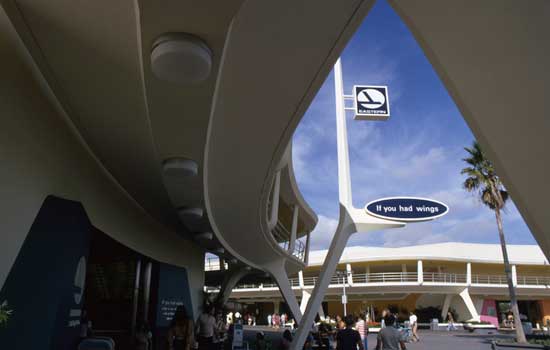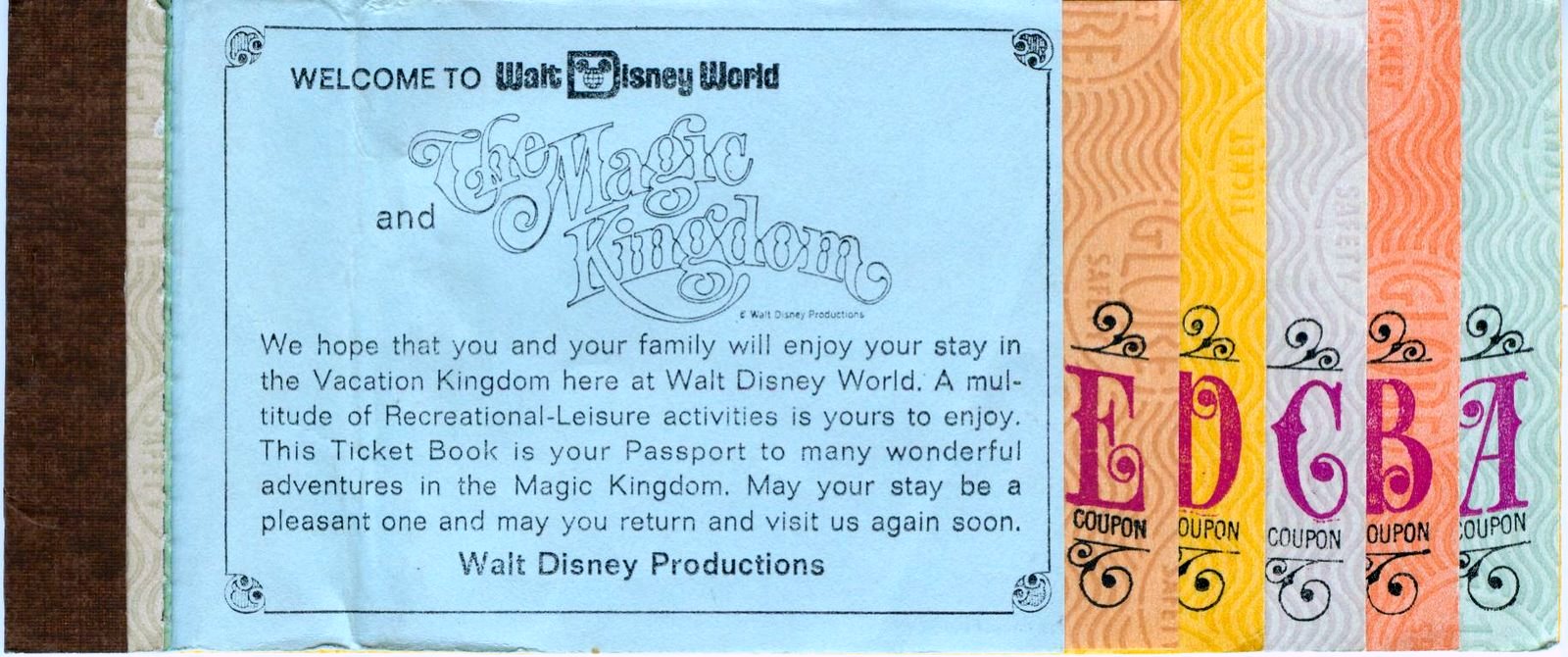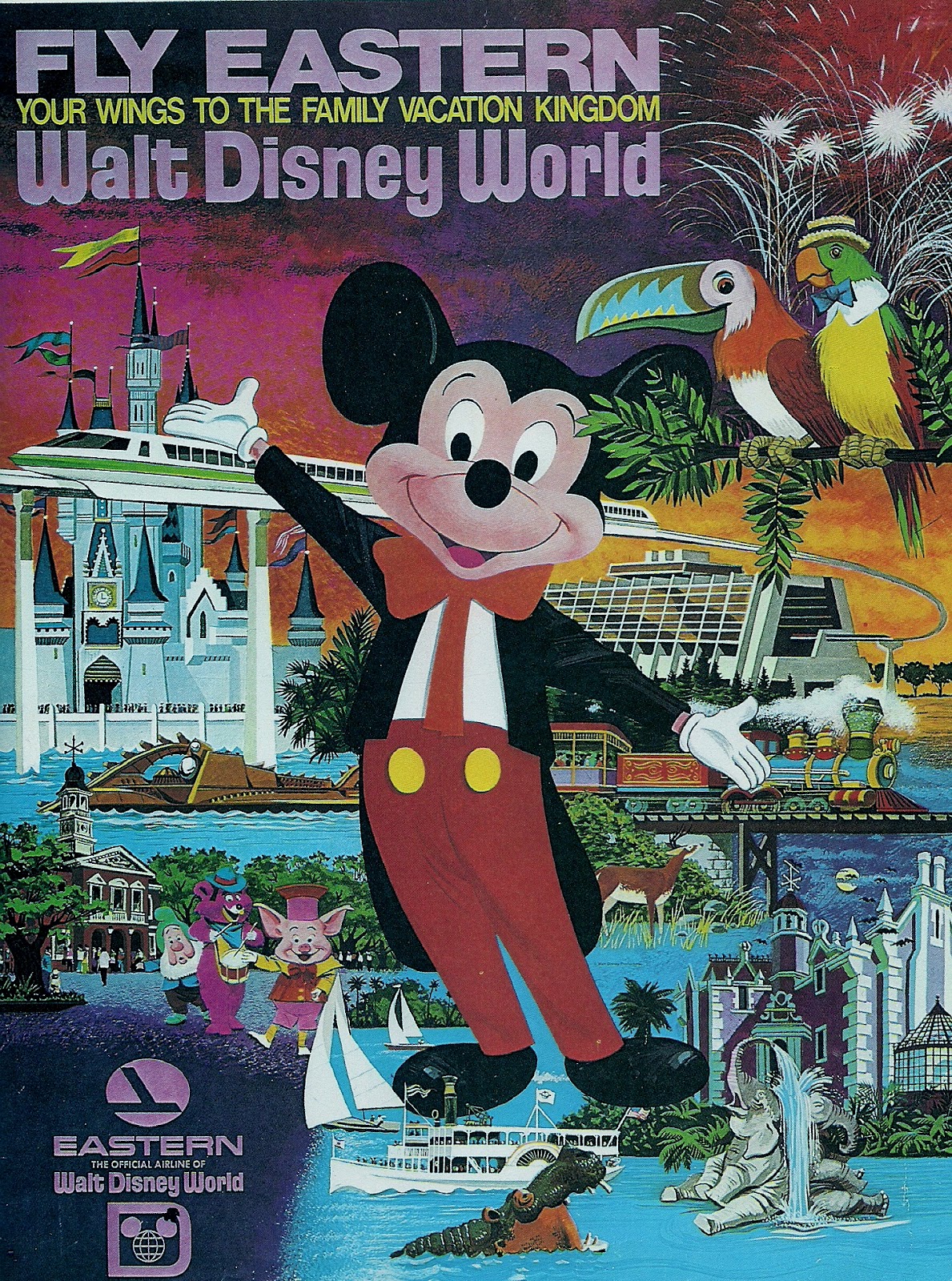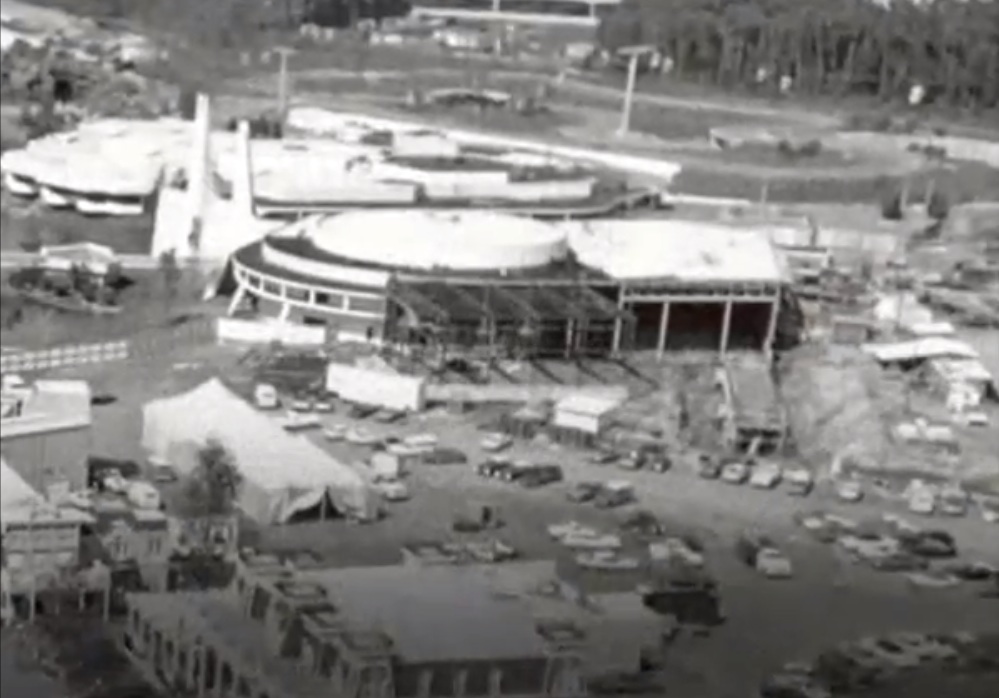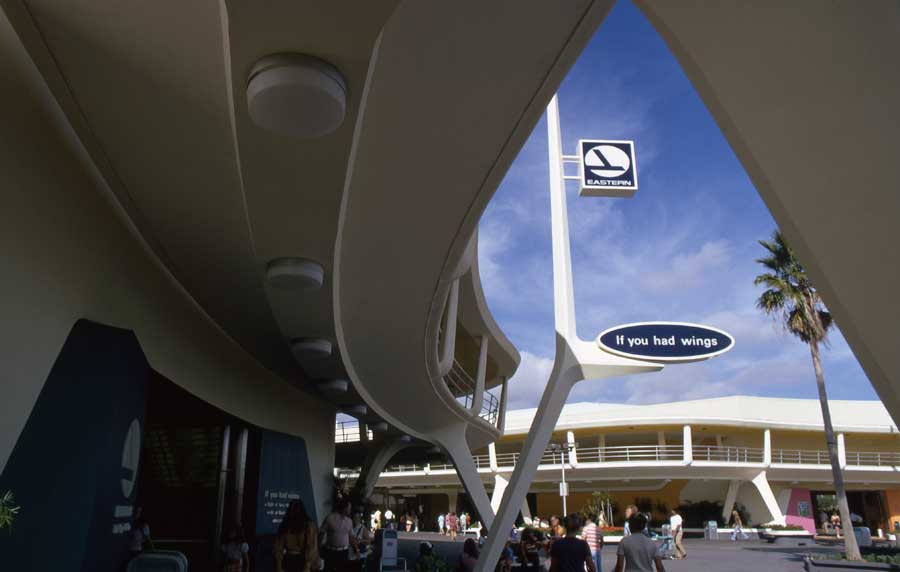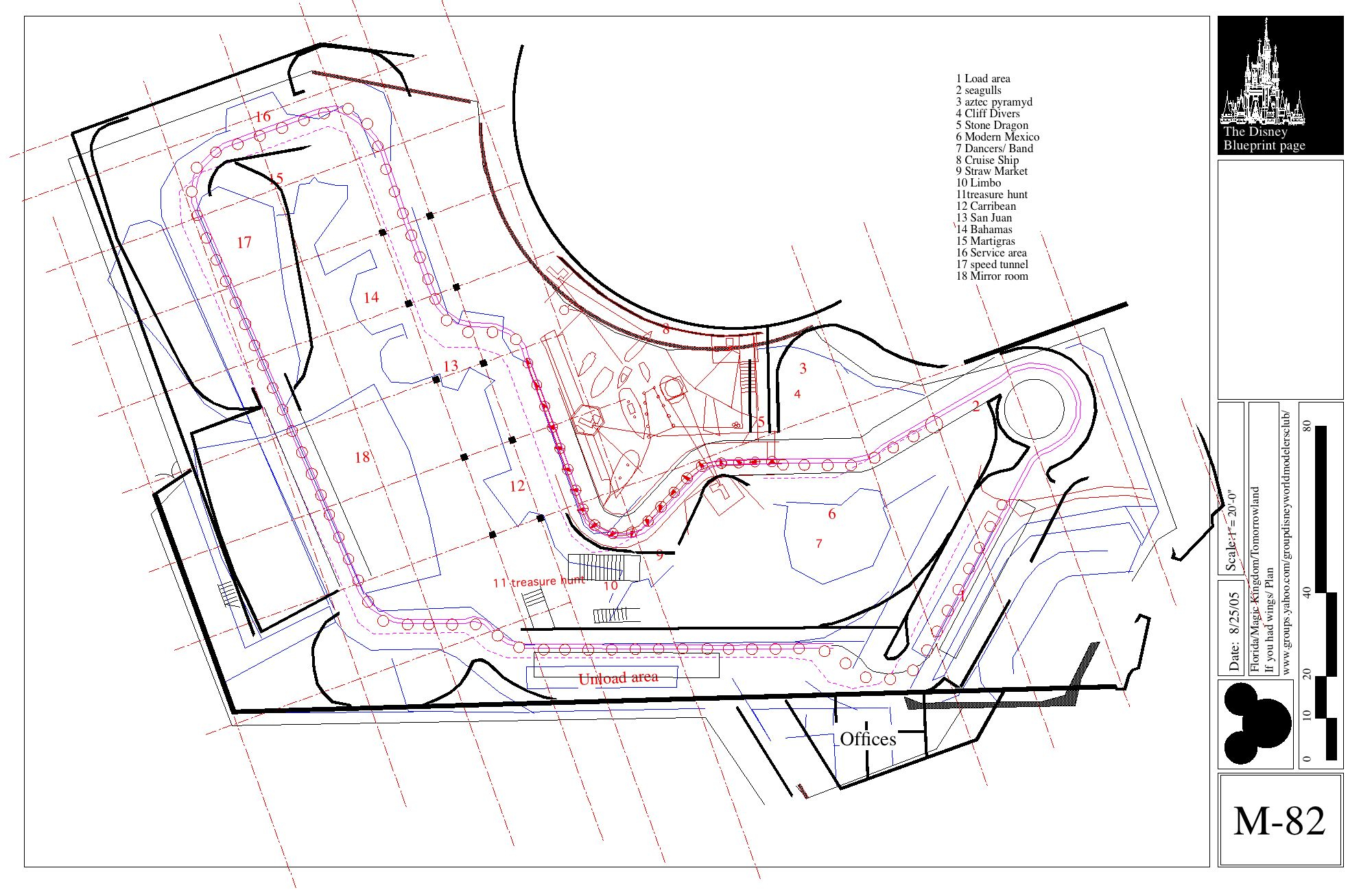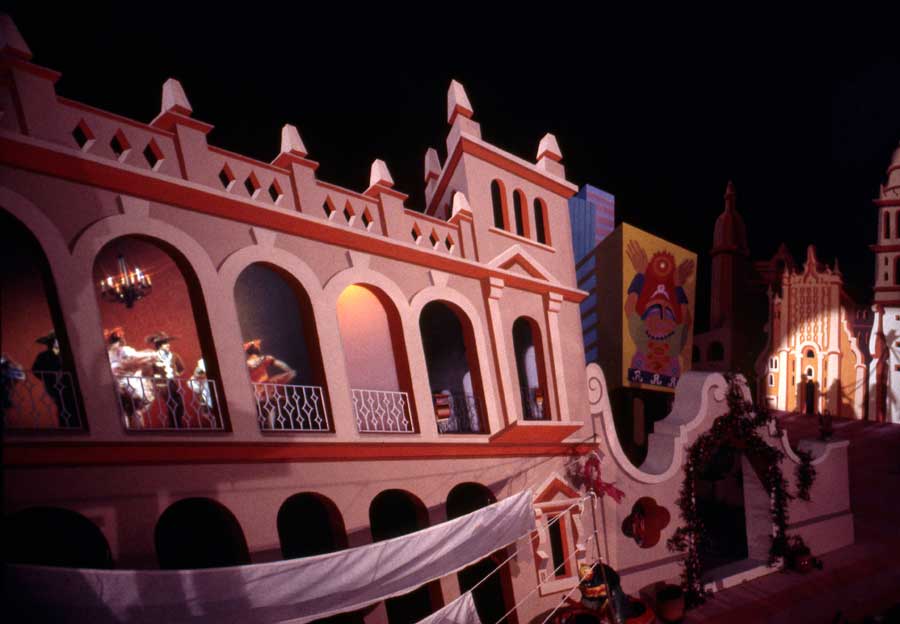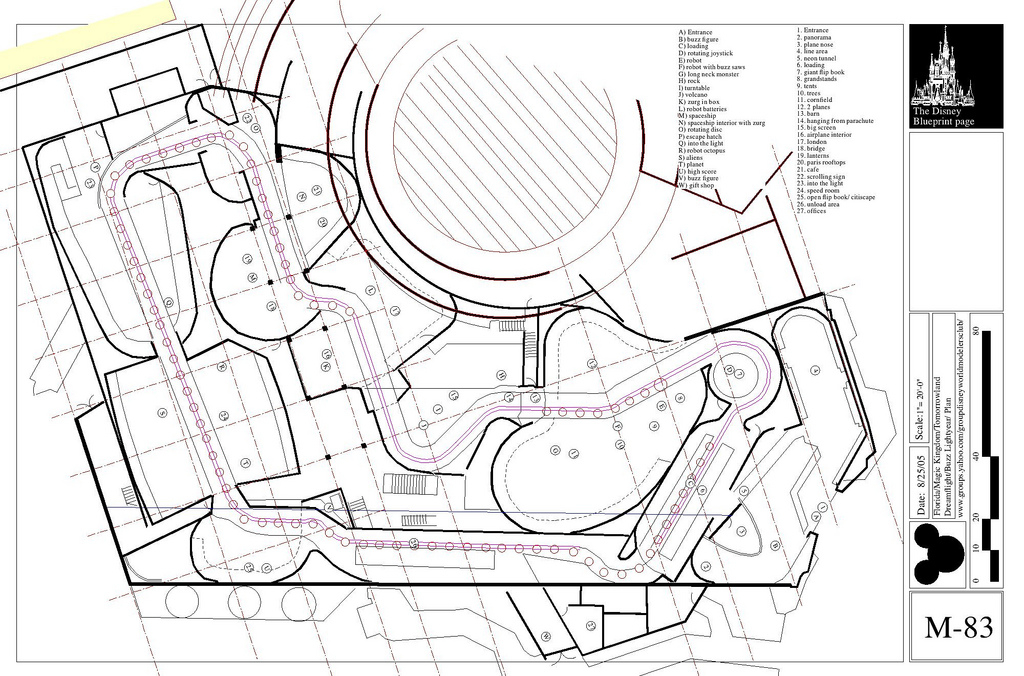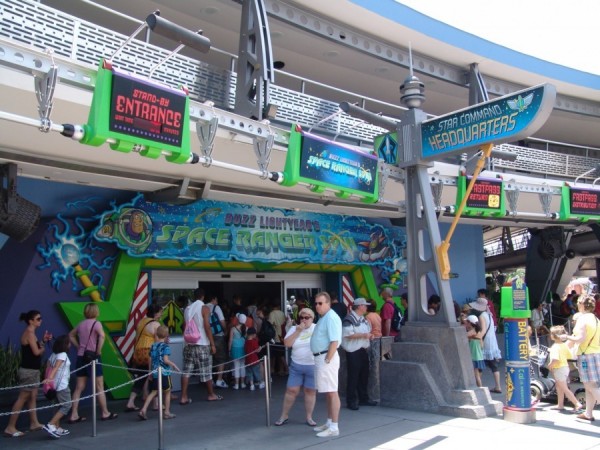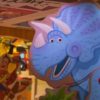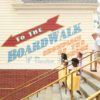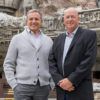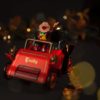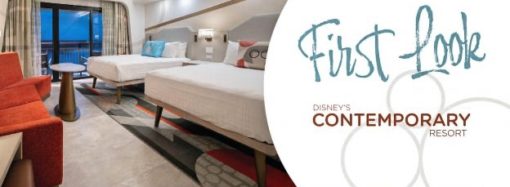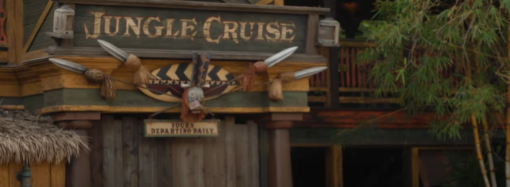From 1971 to 1980, Walt Disney World utilized the ticket book system that Disneyland had been using for many years. Attractions were assigned a letter, A through E, based on the popularity value of the attraction. A few attractions required no admission: The Walt Disney Story, Circle-Vision 360, Carousel of Progress, and If You Had Wings.
When my family and I made our second visit to Walt Disney World in August 1972, we went to the recently opened attraction, If You Had Wings. Opening on June 5, 1972, Eastern Air Lines, which was the official airline of Walt Disney World, sponsored the attraction. Picking a favorite attraction is always difficult, but If You Had Wings always has and will always be one of my favorites.
Although it was a full-fledged commercial for Eastern Airlines and for the routes they flew, nonetheless it was always an exciting attraction that was fun to ride over and over again.
Image: The Walt Disney Company
In September of 1971 construction was moving rapidly to complete The Magic Kingdom. The two buildings marking the entrance to Tomorrowland were built to mirror each other. However, the north building was considerably larger than its southern counterpart due to the fact that it housed the Tomorrowland Terrace Restaurant. Although the south building was completed; it remained empty. At this time work had started on extending a portion of the south building. It had an annex area that was now being enlarged. The first phase of the Tomorrowland expansion included a building that included the addition of another large quick-service food restaurant, the Tomorrowland Terrace, and an extension of the utilidors; that would connect it with the existing utilidor thus completing the ring.
Construction of If You Had Wings Attraction, Tomorrowland
Image: Screengrab from Martins Videos
The new annex area had nothing in it at this time, but half of it went into the basement level. It clearly was being built with an attraction in mind. This new attraction would be unique to Orlando, but was modeled on Adventures Through Inner Space, than a current attraction at Disneyland. The previously open south balcony, which surrounded the building, was now enclosed and spanned the middle of the new attraction. This space eventually became the home of Eastern Air Lines’ If You Had Wings.
According to Widen Your World, “In 1964 Disneyland secured United Airlines as a ten-year sponsor of… (the) new Enchanted Tiki Room attraction. Six years later, there was little doubt that a major airline would be solicited for a similar relationship with Walt Disney World. In 1970, however, United was coming off a decade of diversification and, more importantly, its first year of multi-million-dollar net losses. Additionally, since WDW was under construction there was no opportunity for a company to merely assume the sponsorship of an “existing” attraction as United had done with the Tiki Room in California. Rather Disney was now seeking the commitment of a larger sum of money to bankroll the development of an as-yet-to-be-determined attraction. The exact amount of that “larger sum” was reportedly $10 million. And the airline that proffered this fee turned out to be Eastern Air Lines, by that time a major nationwide air carrier that had dominated air traffic routes along the Atlantic coast since the 1930s. By 1971 Eastern provided flight service to Orlando from 60 different cities.”
With Eastern Air Lines sponsorship secured, “If You Had Wings” went full steam ahead. It was the second attraction in The Magic Kingdom to utilize the Omnimover vehicle system – the first being “The Haunted Mansion.” Claude Coats, who had been instrumental to the design, styling, and backdrops of numerous films and parks since 1937, designed this four-and-one-half-minute dark ride. Coats has often been called the “master of the dark ride format.” The attraction also featured music by Buddy Baker and lyrics by X. Atencio.
The exterior of If You Had Wings
Image: Big Florida Country
The 102 Omnimovers moved guests throughout the attraction at a casual, even pace of two feet per second. The sense of various speeds of motion comes from the use of rear projection films and various other visual effects. Your adventure started at the arrival at the attraction. Passing through the entryway, guests entered the holding area that was to resemble a spacious, modern airport terminal.
Guests walked down a winding switchback queue that resembled the boarding ramp of an airline and stepped onto a speed ramp before boarding a royal blue Omnimover. Guests then were transported through a large opening in an oversized globe. Ironically, the opening was located just south of Florida; so guests “passed through” the Caribbean – part of Eastern’s most popular routes.
Blueprint of If You Had Wings
Image: Ed Film / Enfilm (Flickr)
The attraction took guests through sixteen different journeys or experiences: the globe, the ascending flight, Aztec & Mexico, Mexico City, Caribbean Port, Straw Market, Treasure Hunt, Caribbean Island, Puerto Rico, Bahamian Traffic Scene, Tropical Forest / Jamaica, Trinidad, New Orleans, the Speed Room, the Mirror Room, and the Descending Flight. Video of the complete ride can be viewed here.
The first scene guests experienced as they passed through the globe was first total darkness; then images of white seagulls flying by. Gradually the seagulls turned into jet airplanes taking flight. As the passengers “flew” into the first scene a chorus of singers started singing If You Had Wings.
There are a number of things that guests fondly remember – the first is its theme song. Like the repetitiveness of it’s A Small World, this repetitive yet simple song, has now become one of Walt Disney World’s memorable pieces of music. “If you had wings, you could do many things, you could widen your world if you had wings. If you had wings, if you had wings, if you had wings, had wings, had wings…”
After a trip through Mexico including gliding by two and three-dimensional props, and film projections of an Aztec pyramid, Acapulco cliff divers, a large stone dragon’s head of Quexalcoatl, guests cruise by modern Mexico.
The Mexico section
Image Courtesy of: Big Florida Country
The next memorable thing about this attraction becomes clear – no matter how much the music plays – the clicking sound of the film projectors, thirty-eight 16mm projectors, was clearly audible throughout the ride and mixed in with the music. Oddly enough, this wasn’t a distraction to the ride but led to its charm.
Widen Your World, a website that features extinct Disney attractions hit the nail on the head about the genius of Claude Coats when they said, “There were no moving props or animated figures, but the ride was still very alive. This was due in large part to Claude Coats’ gift for staging. His talents gave the ride a strong sense of atmospheric plausibility.”
My favorite scene was the Caribbean section. It featured an ocean liner with the boarding ramp, passengers lining the deck throwing streamers while a steel drum band played. Below there were smaller boats in the water as divers looked for treasure. To cap off the scene was a tourist standing in front of a sport fishing shack holding his catch – a swordfish. Only this fish changed length as his wife took a photo.
As the journey continued, guests encountered a Bahamian marching band – playing their rendition of If You Had Wings – while various images of street traffic passed by. The theme was repeated throughout this section, but now the street traffic alternated with scurrying flamingos while a Bahamian traffic cop in a white hat, white shorts, and knee socks kept trying to keep control of the traffic.
Guests were then transported to Jamaica’s Dunn River Falls, a lagoon in Trinidad, and then New Orleans French Quarter during Mardi Gras. After the New Orleans scene came the next memorable part of this attraction – the Speed Room.
The Speed Room was one of the most exciting parts of the attraction. As passengers traveled down the middle of this huge bullet-shaped tunnel with various 70mm projections of high-speed adventures are shown on the walls. Titling the Omnimover backward as large fans gave the sensation of motion enhanced the sensation of moving fast through a dune buggy across the desert, water skiing on a lake, or flying down a forest path on a speeding train. Once passengers left the Speed Room they entered the final thrill of the ride – the Mirror Room. This room is exactly as it sounds; a box-shaped room covered with large floor-to-ceiling mirrors that had two 70mm projectors reflecting images of snow-capped mountains and other relaxing scenes. These scenes were shot in an upward motion – giving another type of forced perspective – that of being lifted.
As the riders exited the mirror room Orson Wells’s voice caressed the passengers with: “You do have wings. You can do all these things. You can widen your world. Eastern: the wings of man.” According to Wikipedia, “At the time of the ride’s inception, ‘The Wings of Man’ was the slogan of Eastern Air Lines. In later years, this passage (spoken by someone other than Welles; perhaps Disney vocal warhorse Peter Renaday) ended with the less grandiloquent, “Eastern: we’ll be your wings.” As guests disembarked their vehicles there was a manned Eastern Air Lines reservation desk ready to help guests make reservations., presumably after being inspired by the attraction. Probably few ever took advantage of this “service.”
In early 1987, Eastern Air Lines withdrew and the attraction was closed in June of that year. Some speculated that Eastern discontinued their sponsorship as part of cutbacks and budget concerns, however in The Philadelphia Inquirer, staff writer Neill Borowski’s article entitled “Disney Gang No Longer Flying Eastern Airlines,” (June 25, 1987) said that not only will Eastern Airlines not be the sponsor of the attraction, but also it has been removed as the official airline. Delta Air Lines has now become both the official airline of Walt Disney World and the new attraction’s sponsor. The article states, “Disney World declined to say which side broke off the relationship with Eastern… however, Eastern spokeswoman Paula Musto said that in recent years, ‘how much that association was worth was being questioned.’” She continued to say, “Such an association afforded Eastern the pleasant feelings, but ‘warm fuzzies are less important than direct, hard-hitting programs.’”
Disney quickly removed all traces of Eastern Air Lines from the attraction and on June 6, 1987, had Delta Air Lines’ name on the attraction and renamed it, “Delta Dreamflight.” According to The Philadelphia Inquirer, “this new-found friendship with Mickey and the gang will cost Delta between $20 million and $30 million over the next 10 years, but Delta expects the return on its investment to come in both image and more business.”
Delta Dreamflight used the same track layout and ride vehicles, but all new scenery and music were added. In January 1996, Delta pulled their sponsorship of the attraction partly because of financial reasons and partly because of their sponsorship of the 1996 Summer Olympics. The attraction’s name was changed to simply Dreamflight, and operated until June 1996, when it then became known as “Disney’s Take Flight.” Unlike the change in scenery and music from “If You Had Wings” to Delta Dreamflight, Disney’s Take Flight kept basically the same scenery and made only minor tweaks to the lyrics.
Blueprint of Dreamflight / Buzz Lightyear’s Space Ranger Spin
Image: Courtesy of Ed Film / Enfilm (Flickr)
In January of 1998, Disney’s Take Flight closed and virtually everything associated with the attraction was removed. Wanting to start incorporating some of Pixar’s properties into their parks on November 3, 1998, Disney officially unveiled Buzz Lightyear’s Space Ranger Spin. Space Ranger Spin uses a combination of elements from its predecessors and all new scenes (the speed tunnel is the original speed tunnel from If You Had Wings).
One other alteration to the attraction involved the Tomorrowland Transit Authority (TTA), formally known as the WEDway Peoplemover. The TTA takes visitors on a birds-eye view of Tomorrowland. As it does, it passes around the south side of the show building. When the attraction was If You Had Wings, riders passed by three windows that looked down inside the attraction. They saw sections of Mexico, Trinidad, and Jamaica. When the ride was altered for Delta’s Dreamflight, the three windows had to be altered because they no longer aligned correctly with the attraction’s scenes. The first window was fitted with a backlit screen that showed one the barnstorming scene. The second window looked into the Parisian excursion scene, but the height and angle ruined the forced perspective of the scene. And the third window would have had guests staring directly into extremely bright light – therefore that window was covered up with plywood and black fabric. Presently, the windows now show a salon scene; a look into the attraction and the third window is still blacked out.
Whether you loved If You Had Wings or remember the attraction simply because you rode it on your first visit to The Magic Kingdom, it will always have a special place in the hearts and minds of many past Walt Disney World guests and current fans.
This article origianlly appeared on the DISUnplugged, 5 August 2012. It is reprinted with permission from the author.
References:
Wikipedia
Walt Disney World: The First Decade, (The Walt Disney Co., 1982)
Borowski, Neill, (25 June 1987). Disney Gang No Longer Flying Eastern Airlines. The Philadelphia Inquirer.
Widen Your World
Big Florida Country
www.martinsvids.net
Diagrams created by and used with permission: Ed Film, enfilm
